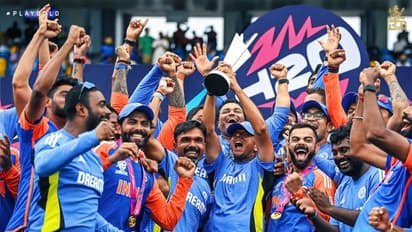Dravid signs off as India coach with T20 WC high; The Wall's stirring roar with trophy wins hearts (WATCH)

Synopsis
Rahul Dravid's tenure as India's head coach concluded gloriously with their T20 World Cup victory, serving as a prime example of how to blend dignity and subtlety in modern cricket coaching.
Rahul Dravid's tenure as India's head coach concluded gloriously with their T20 World Cup victory, serving as a prime example of how to blend dignity and subtlety in modern cricket coaching. However, even 'The Wall' crumbled under the weight of emotions after breaking an 11-year title drought.
The moment Dravid touched the trophy, brought to him by the player of the match Virat Kohli, he let out a ferocious roar, releasing the emotions he typically keeps hidden from the public eye.
This uncharacteristic outburst from Dravid, known for his composed demeanor and understated quotes, highlighted his steadfast commitment to his role, reminiscent of Gary Kirsten's coaching style.
Despite his minimalist approach, Rahul Dravid faced immense challenges during his nearly three-year tenure as head coach of the world's most followed cricket team.
The scrutiny on Dravid began even before his official appointment. He was seen as the 'Next One' while leading India in a brief white-ball series against Sri Lanka in mid-2021.
This series served as his audition, a real-time interview to gauge his ability to handle the pressures of the high-profile role, before he was officially appointed in November of that year.
From the beginning, Dravid was expected to live up to the lofty standards set by his predecessor, Ravi Shastri, who led India to a successful run, including consecutive away series wins in Australia, considered the Holy Grail of Test cricket for subcontinental teams.
Although Dravid never had the chance to coach in Australia, he managed to triumph over the Antipodeans at home in various formats.
However, a defeat and a drawn Test series against a 'weaker' South African side will always rankle Dravid, for whom victories away from home were the gold standard.
These are common challenges faced by any coach. Yet, Dravid encountered harsher tests unique to the Indian cricketing culture.
He managed a dressing room full of superstars, an environment he was familiar with from his playing days. Dravid knew that even the slightest discord could be blown out of proportion.
Recall the exit saga of Anil Kumble's tenure and eventual ouster. Dravid, however, possessed the invaluable ability to read people and situations, channeling this skill into his coaching stint.
He implemented his strategies without dismantling the existing system, fostering a harmonious environment with captain Rohit Sharma that allowed players to thrive.
A notable example is Mohammed Siraj. The pacer started his career during Shastri's tenure but blossomed into an all-format bowler under Dravid's guidance.
However, the journey wasn't always smooth.
To start, three key batters—Virat Kohli, Ajinkya Rahane, and Cheteshwar Pujara—were gradually falling out of form.
Kohli, who was always likely to get more opportunities, made Dravid's job easier by rediscovering some of his scoring touch. In contrast, Rahane and Pujara were nearing the end of their effectiveness as top-level batters.
Their inability to perform in the World Test Championship final against Australia in London last year accelerated their departure.
Despite their declining performance, Pujara and Rahane had been mainstays of the Indian middle order for a long time, and managing their transition required a delicate approach.
Drawing on his extensive experience with players during 'A' tours and developmental stages, Dravid tackled his task with foresight. He promptly handed Shreyas Iyer a debut in his inaugural Test series as coach, against New Zealand at home.
Iyer repaid the trust with a remarkable century. Ironically, both Iyer and Ishan Kishan—whom Dravid had heavily invested in—later faced controversy, resulting in their exclusion from the BCCI central contract.
Despite these anomalies, Dravid's approach was fundamentally sound, extending into ODIs where he prioritized expanding the pool of young talents.
This approach mirrored his captaincy days when, alongside then-coach Greg Chappell, he experimented with emerging players like Suresh Raina, Y Venugopala Rao, and Rudra Pratap Singh, achieving varying degrees of success.
Dravid, in collaboration with Rohit, implemented a similar strategy by promoting talents such as Shubman Gill, Ishan Kishan, Yashasvi Jaiswal, Mohammed Siraj, and Suryakumar Yadav, who had previously lacked consistent opportunities under the previous regime.
These players justified the trust placed in them, contributing significantly to India's triumph in the Asia Cup in Sri Lanka last year. Gill and Siraj emerged as India's top performers in batting and bowling, respectively.
Yet, there remains a lingering regret for Dravid, particularly missing out on winning the 50-over World Cup at home, where his team fell short against Australia in the final.
The victory in the World Cup at Barbados could have alleviated some of that disappointment. Surprisingly, it came in a format where Dravid, contrary to his usual methods, largely adhered to conventional approaches.
However, this doesn't suggest Dravid was out of touch with the format, as evidenced in recent performances.
Looking ahead, how will Dravid's coaching tenure be remembered?
Undoubtedly, the World Cup triumph will dominate public memory. Yet, perhaps more significantly, his adept management of a team filled with high-profile individuals will form the legacy against which his successors will be measured—a formidable challenge in itself.
Stay on top of all the latest Sports News, including Cricket News, Football News, WWE News, and updates from Other Sports around the world. Get live scores, match highlights, player stats, and expert analysis of every major tournament. Download the Asianet News Official App to never miss a sporting moment and stay connected to the action anytime, anywhere.